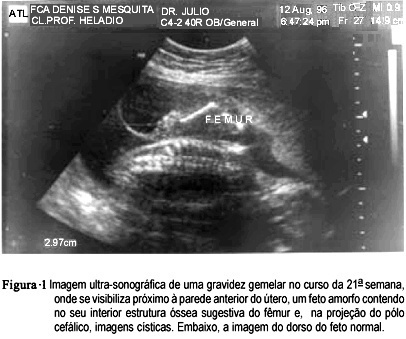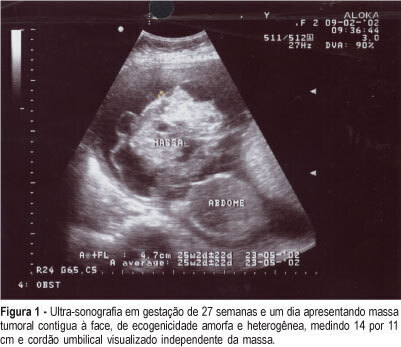Summary
Revista Brasileira de Ginecologia e Obstetrícia. 1998;20(2):111-113
DOI 10.1590/S0100-72031998000200009
The acardius syndrome is a rare complication of monozygotic twin pregnancies, occurring once in 35.000 births. The outcome is invariably fatal for the acardiac twin and for 50-75% of the normal twins. We report a case of partial (pseudo)acardia in twin pregnancy. The diagnosis was made using ultrasonography, fetal echocardiography and confirmed after delivery.

Summary
Revista Brasileira de Ginecologia e Obstetrícia. 1998;20(5):283-287
DOI 10.1590/S0100-72031998000500008
Turner syndrome and its complications, hydrops and cystic hygroma, can produce alterations in maternal serum biochemical markers used in screening for Down's syndrome and neural tube defects (NTD). The authors report the case of a 37-year-old pregnant woman, screened for Down's syndrome and NTD in the second trimester of pregnancy. The maternal serum alpha-fetoprotein (MSAFP) level was increased and the test was considered screen positive for NTD. A three-dimensional ultrasound investigation was performed, but no fetal or placental anomalies were found, indicating a case of unexplained increased msafp. In the third trimester severe oligohydramnios and disturbances in uteroplacental arterial circulation developed, requiring corticosteroid therapy and premature cesarean section at the 34th week of gestation. The female newborn was transferred to a neonatal ICU and tetralogy of Fallot and Turner syndrome were diagnosed. This case prompted the authors to review the literature on maternal serum biochemical markers in Turner syndrome and congenital heart defects and to propose a protocol for unexplained increased MSAFP.
Summary
Revista Brasileira de Ginecologia e Obstetrícia. 1998;20(8):449-453
DOI 10.1590/S0100-72031998000800004
Purpose: to determine folate, vitamin B12 and ferritin levels in patients whose fetuses presented neural-tube defects (NTD). Blood folate and vitamin B12 act as cofactors of enzymes involved in DNA biosynthesis. Interruption of this process may block neural-tube closing. Vitamin supplementation with folate may reduce occurrence rates and recurrence of NTD, although there is concern about the fact that this prevention may mask vitamin B12 deficiency. Methods: vitamin B12 and ferritin determinations by enzyme immunoassay with microparticles and folic acid determination using the ion capture method (IMx ABBOTT). Results: the percentage of pregnant women with vitamin B12 deficirncy (serum levels < 150 pg/ml) was 11.8%. There was no case of folate deficiency (serum levels < 3.0 ng/ml) and prevalence of pregnant women with iron store deficiency was 47.1% (serum levels < ng/mg). Conclusions: occording to the results obtained in this study (prevalence of 11.8% of vitamin B12 and 0% of folate deficient pregnant women) we suggest that supplementation should be administered after serum vitamin B12 determination.
Summary
Revista Brasileira de Ginecologia e Obstetrícia. 1999;21(4):235-238
DOI 10.1590/S0100-72031999000400009
We report a case of nonmolar fetal triploidy detected by fetal blood sampling at 20 weeks of gestation, performed as an investigation of intrauterine growth retardation and severe oligohydramnios found by ultrasound scan. At 19 weeks of gestation very low levels of maternal free serum beta-subunit of human chorionic gonadotropin and unconjugated estriol, and normal levels of alpha-fetoprotein were found, which were interpreted as a high risk of fetal Edwards syndrome. Fetal death supervened the day after fetal blood sampling, and the pregnancy was terminated by vaginal delivery induced by misoprostol and oxytocin, under epidural anesthesia. Chromosome study of the fetal blood cells showed a 69,XXX karyotype. The severe intrauterine growth retardation and macrocephaly noted on pathological review plus the very low levels of hCG and unconjugated estriol suggest a fetal gynoid triploidy case, caused by the fertilization of a diploid egg by a haploid sperm.
Summary
Revista Brasileira de Ginecologia e Obstetrícia. 1999;21(7):393-397
DOI 10.1590/S0100-72031999000700005
Purpose: to evaluate a possible relationship between fetal malformations (FM) and the use of sulfonylureas (SF) by diabetic pregnant women. Methods: we retrospectively studied 35 type 2 diabetic pregnant women followed at the Pathological Prenatal Care Outpatient Clinic of the University Hospital, Faculty of Medicine of Ribeirão Preto, from 1993 to 1995. Twenty-two of these women had been inadvertently using sulfonylureas during the 1st trimester of gestation (SF group). We determined their prevalence of FM and compared it to that observed for pregnant diabetic women who were only on diet or insulin therapy (group C). We also analyzed other variables such as time of disease, age, metabolic control, and prenatal care. Results: there was no significant difference between groups in terms of age range, duration of diabetes, glycemic control, or early start of prenatal care, with the prevalence of FM being similar for the two groups (8.3% in group C and 13.6% in group SF). The malformations observed in group SF were: renal agenesis, pulmonary hypoplasia and ribbon gonads (patient 1); short limbs and abnormally implanted toes (patient 2); cleft palate, low implanted ears, neck webbing and saddle nose (patient 3), and micrognathia, dysplastic ears, imperforate anus, hypospadia, polydactily, ventricular septal defect and atrial septal defect (patient 4) in group C. Conclusions: these data do not allow us to attribute the malformations detected in group SF to the use of sulfonylureas, although not usually described alterations in diabetic embryopathy occurred in this group.
Summary
Revista Brasileira de Ginecologia e Obstetrícia. 2000;22(4):191-199
DOI 10.1590/S0100-72032000000400002
Purpose: to determine the frequency of prenatal diagnosis in newborns with gastroschisis operated at the Instituto Materno-Infantil de Pernambuco (IMIP) and to analyze its repercussions on neonatal prognosis. Patients and Methods: a cross-sectional study was carried out, including 31 cases of gastroschisis submitted to surgical correction in our service from 1995 to 1999. Prevalence risk (PR) of neonatal death and its 95% confidence interval were calculated for the presence of prenatal diagnosis and other perinatal and surgical variables. Multiple logistic regression analysis was carried out to determine the adjusted risk of neonatal death. Results: only 10 of 31 cases of gastroschisis (32.3%) had prenatal diagnosis and all were delivered at IMIP. No newborn with prenatal diagnosis was preterm but 43% of those without prenatal diagnosis were premature (p < 0,05). Birth-to-surgery interval was significantly greater in the absence of prenatal diagnosis (7.7 versus 3.8 hours). The type of surgery, need of mechanical ventilation and frequency of postoperative infection were not different between the groups. Neonatal death was more frequent in the group without prenatal diagnosis (67%) than in the group with prenatal diagnosis (20%). The main factors associated with increased risk of neonatal death were gestational age <37 weeks, absence of prenatal diagnosis, delivery in other hospitals, birth-to-surgery interval > 4 hours, staged silo surgery, need of mechanical ventilation and postoperative infection. Conclusions: prenatal diagnosis was infrequent among infants with gastroschisis and neonatal death was extremely high in its absence. It is necessary to achieve greater rates of prenatal diagnosis and to improve perinatal care in order to reduce this increased mortality.
Summary
Revista Brasileira de Ginecologia e Obstetrícia. 2005;27(2):86-91
DOI 10.1590/S0100-72032005000200008
Oropharyngeal teratoma is the most rare type of teratoma, with only 2% of fetal teratomas. The diagnosis must be established as early as possible, preferably during the prenatal period. The prognosis will depend on the size and location of the lesion, growth rate of the lesion, degree of intracranial spread, its resectability, and immediate care at birth by a multisciplinary team. We report aparticular case of congenital oropharyngeal teratoma (epignathus). The diagnosis was made during the prenatal period by ultrasound, and the fetus evolved to intrauterine death at the 29th week. The anatomopathological examination revealed a female fetus, compatible with 27-28 weeks, oropharyngeal teratoma and congenital malformations.

Summary
Revista Brasileira de Ginecologia e Obstetrícia. 2004;26(2):89-96
DOI 10.1590/S0100-72032004000200002
PURPOSE: to evaluate knowledge, opinion and practice of gynecologists/obstetricians regarding induction of abortion. Method: a pretested, structured questionnaire was sent to gynecologists/obstetricians affiliated to FEBRASGO. They were asked to answer and return the questionnaire in a self-addressed, prepaid envelope, without identification of the respondent so as to preserve anonymity. Knowledge about the legal situation of abortion in Brazil, opinion about it and practice if confronted with abortion requests were questioned. RESULTS: approximately 90% of the respondents believed that abortion is legal for pregnancy resulting from rape or in case of risk to a woman's life and for 31.8% in case of severe fetal malformation. In their opinion abortion should be permitted in the case that pregnancy is a risk for a woman's life (79.3%), fetal malformation (77.0%) and after rape (76.6%), added to 9.9% who expressed that abortion should be permitted in all circumstances. Two thirds wrongly thought that a judicial order is required to practice a legal abortion and only 27.4% knew that a written request by the woman is required. Confronted with unwanted pregnancy, 77.6% of female gynecologists/obstetricians and 79.9% of partners of male respondents had an abortion, 40% would help a client and 48.5% a relative in the same situation. CONCLUSION: gynecologists/obstetricians lack knowledge on the legal situation of abortion although their opinion and practice are favorable.